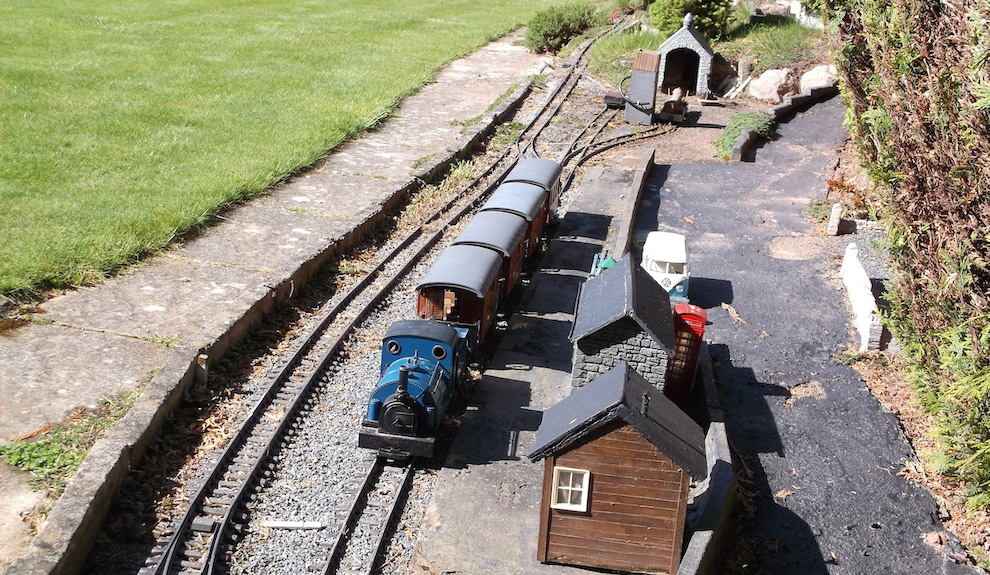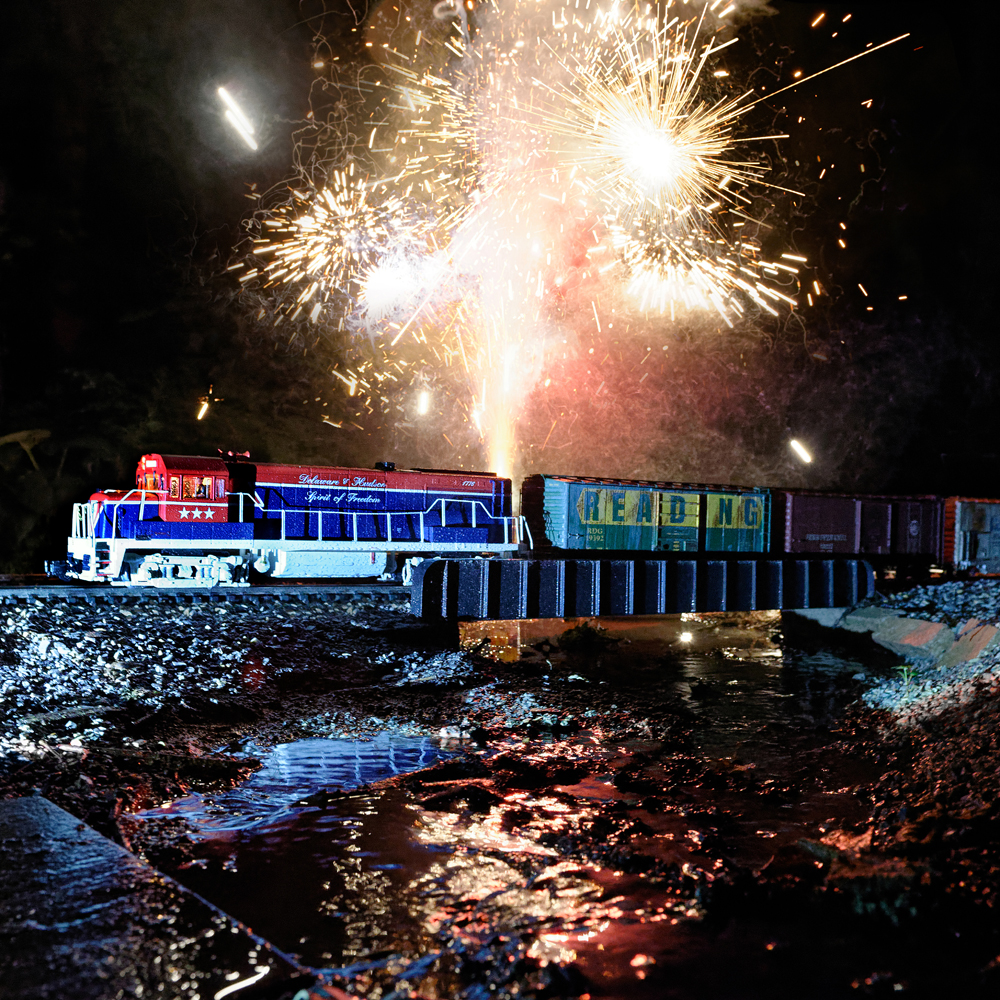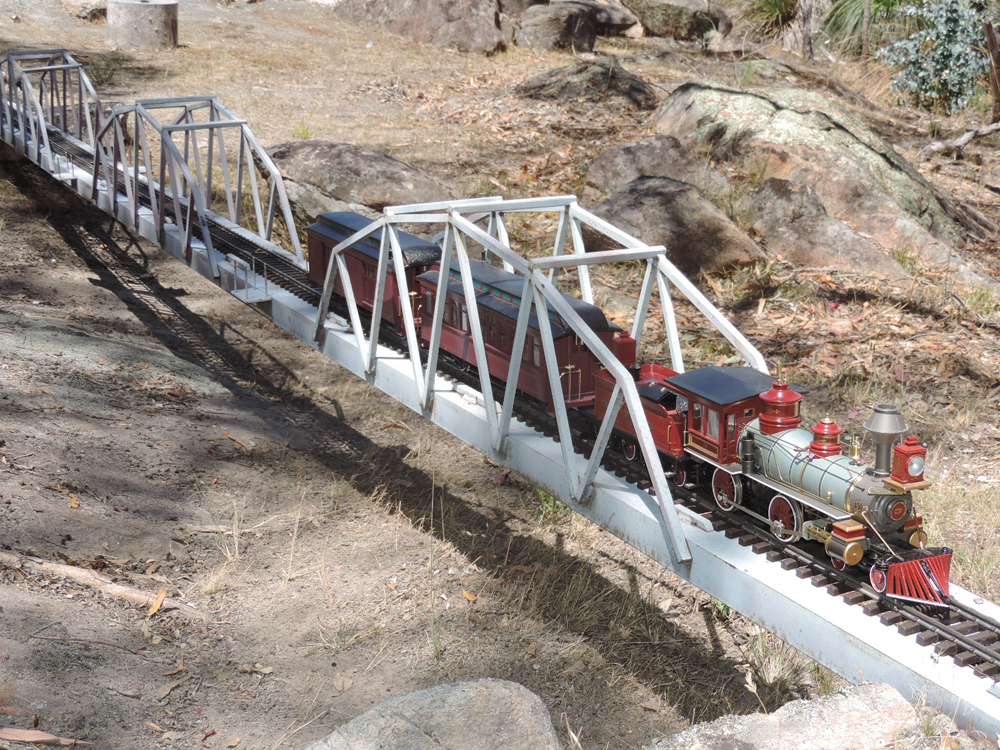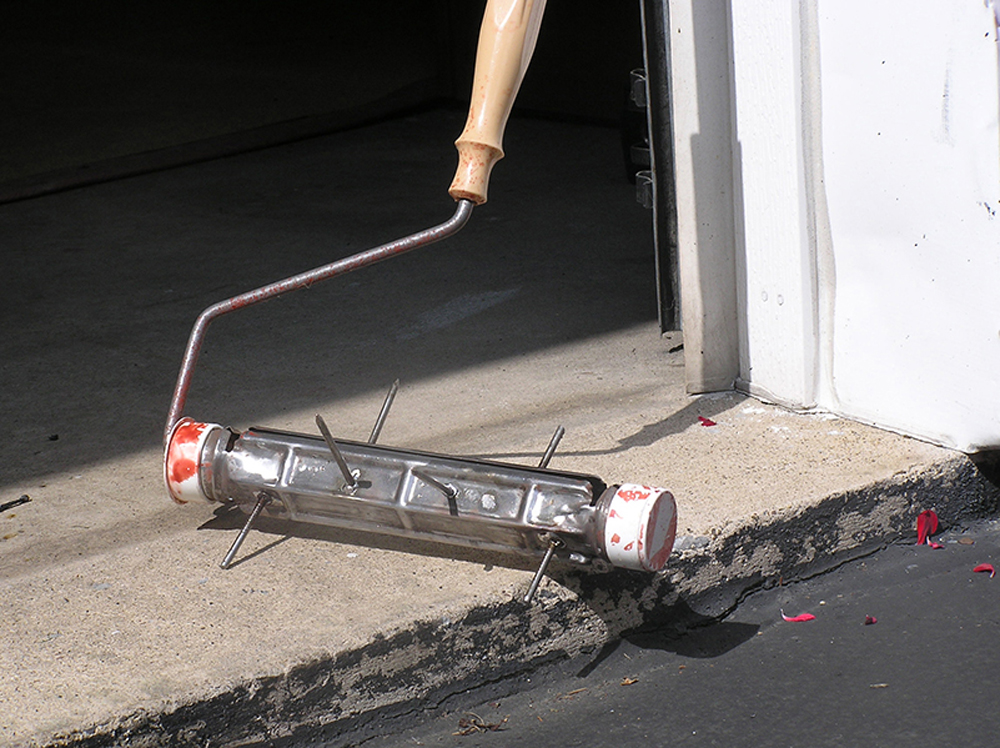Rails in New England: I lived in New England for 40 years. On a recent trip back to the northeast corner of the USA, I visited garden railways, mostly on the coast where trees often grow up to the shore. I also chanced upon some full-scale historic railways, which seemed to crop up everywhere.
Predating trains
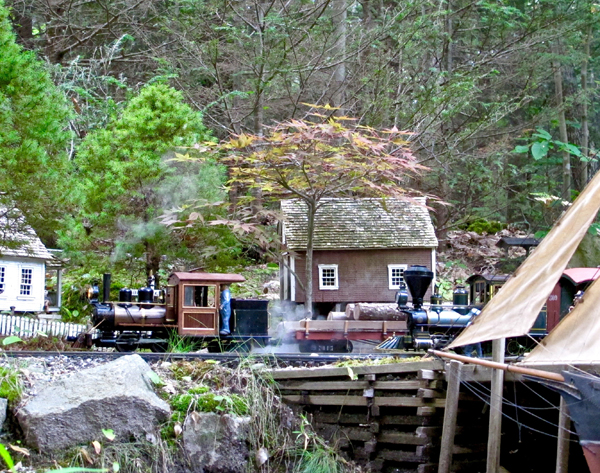
In an area that reveres history, it’s common knowledge in my hometown, north of Boston, that Andover was settled in 1642. In photo 1, Eric Schade’s town of Phippsburg, Maine, was the first-known New England settlement attempt (by the English) back in 1607. Eric models the historic use of lumber for clapboard houses, fencing, cribbing, docks, ships, railroad ties, and locomotive cabs. Rivers were used to float logs to lumber mills, then railroads were built through the woods using Maine’s famous two-foot-narrow-gauge rails.
Due to its rich history (and great seafood), tourism is now one of the largest industries in Maine—no longer do most Mainers produce lumber, paper, or ships. Eric volunteers at the narrow-gauge excursion line, Wiscasset, Waterville & Farmington Railway Museum (http://wwfry.org), “rebuilding Maine history.”
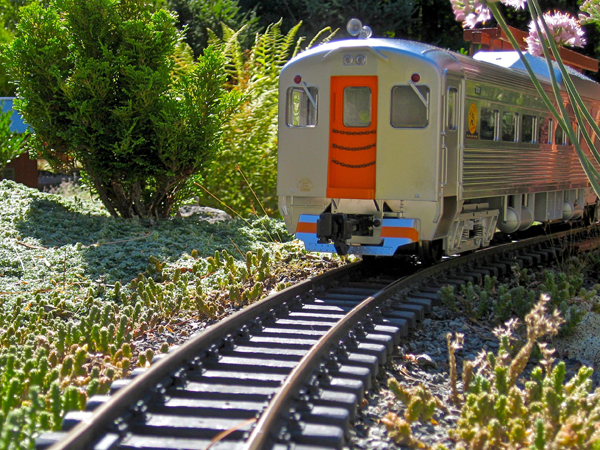
Dave Miller, president of the New Hampshire Garden Railway Society (www.nhgrs.com), lives on a clearing in the woods. His backyard railway is a classic miniature garden of dwarf trees and tight, low groundcovers (photo 2). Like many railway clubs, the NHGRS sets up seasonal modular-railway displays that model local industries.
Natural history
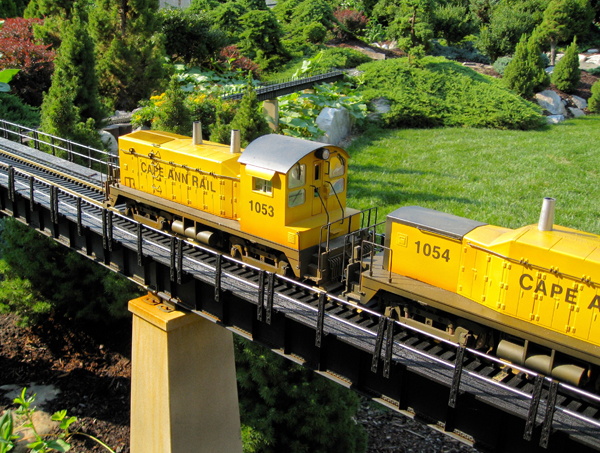
Mark Twain said about New England, “If you don’t like the weather, wait a minute.” Warmed by the Atlantic’s Gulf Stream from the south and chilled by ice melt from the north, the coast north of Portland, Maine, has almost no beaches—just rocky cliffs that drop to the waves. Eons ago, glaciers scraped away eastern Maine’s topsoil and bestowed that soil as sand on New Hampshire beaches, then south to Massachusetts peninsulas Cape Ann (photo 3) and Cape Cod, and finally created Long Island, New York (photo 4).
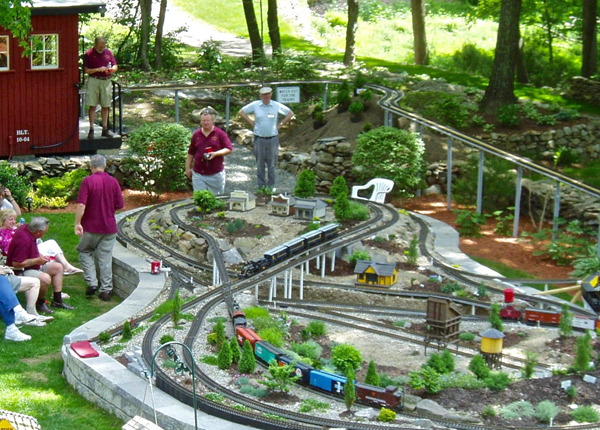
With frequent rain, New England soil is on the acidic side, but bagged-limestone dust can adjust the pH for fussy “transplants from away.” Rocky, shallow soil grows north of Portland, and sandy, poor soil lives south to Rhode Island’s coastal gardens (photo 5).
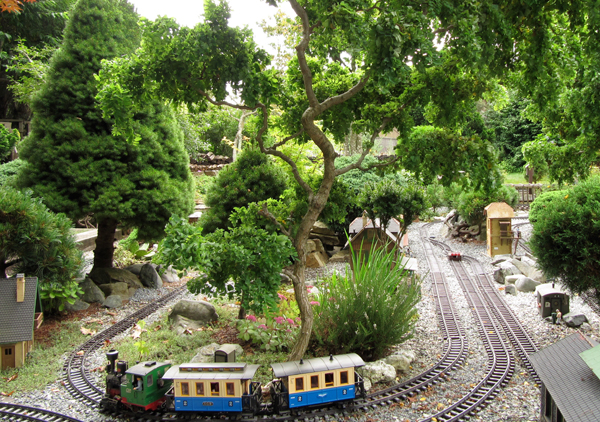
Photo 5: In Rhode Island, Manny Neronha runs the railroad but wife Veronika does the gardening in a style reminiscent of the English gardens in which she grew up. With a mystical canopy of mature shrubs and small trees, one must walk around their railway garden of miniatures to see it all. Nancy Norris photo
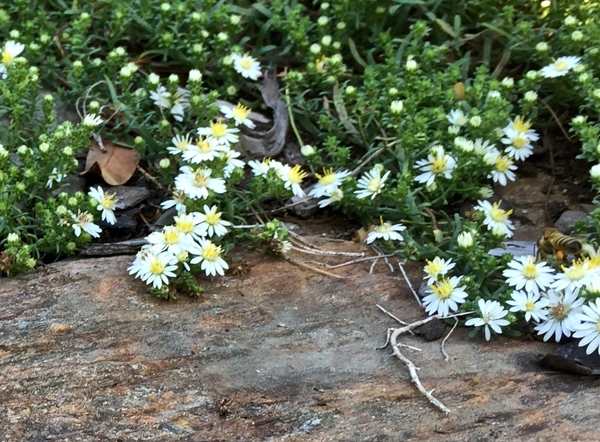
In search of suitable plants, I visited Coastal Maine Botanical Gardens (www.mainegardens.org), and found three good groundcovers for New England soil. Almost like heather with daisies, snow flurry heath aster (Aster ericoides ‘Schneegitter’, Zones 4-8) hugs the ground and trails over rocks (photo 6). Prostrate blue spruce (Picea pungens ‘Prostratus’, Zones 2-7) is a creeping variety of Colorado blue spruce. The shiny, rugged, evergreen foliage of bearberry (Arctostaphylos uva-ursi ‘Massachusetts’, Zones 2-6) stays low, with white-bell flowers in spring and loads of red berries summer to fall.
Getting through winter
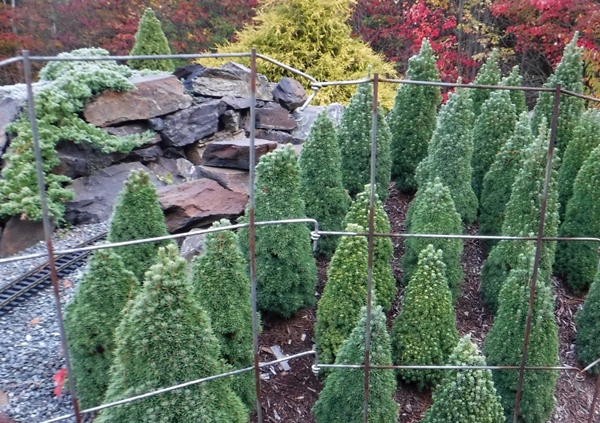
Plant life can’t fly south for the winter, as do Paul and Brenda Smith. In late fall, for their Bagley Mountain Division of the Maine Central Railroad (photo 7), Paul makes a wire fence from tomato cages that he got online (www.gardeners.com/buy/plant-supports/vegetable-supports). Clothespinned burlap will shield his miniature spruce from the drying winter sun. It helps to soak the ground before flocking to Florida with other “snowbirds.”
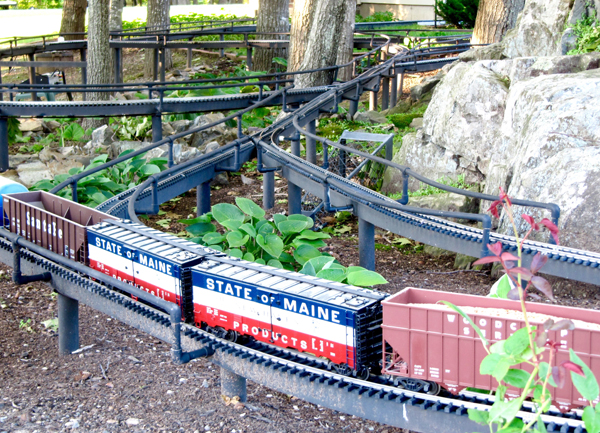
Some “Mainiacs” run their scale snowplows to get in a few winter runs. See Eric Schade’s snowy steam run (https://www.trains.com/grw/videos-photos/videos/member-videos/double-headed-live-steam-snow-plowing/). Ralph and Sue Luby don’t need a snowplow. Black PVC-pipe roadbed catches the sun and melts the snow, so they might be able to run trains by the afternoon (photo 8).
I’m sorry I didn’t get over to Vermont to see garden railways there, but the former president of the Vermont Garden Railway Society recently moved to Maine, according to my Maine GRS newsletter, so now I know Vermont railways exist for a future trip. Check out GR’s links to public railways online: http://grw.trains.com/permanent-railways
Open-air railway museums
I grew up going to the largest outdoor museum in New England—a park whose theme predates railroad history: Old Sturbridge Village. Years ago I took a ride at the Maine Narrow Gauge Railroad & Museum on Casco Bay. Recently I visited other Maine open-air museums that focus on railroad history.
Driving inland from Maine’s Botanic Gardens, a two-foot-gauge Edaville diesel in front of a depot caught my eye. I pulled a U-turn to visit Boothbay Railway Village, “where history moves you.” Go to htpps://railwayvillage.org to see their model railroad in progress and read about Maine’s railroad history. I took photos of their 1886 Merci boxcar that I’d like to model, because of an unusual brakeman’s house on the end. In 1949, France sent 49 “Merci” (gratitude) cars filled with gifts to the people of the United States: http://mercitrain.org
On the road again, after visiting family in Kennebunkport, I was surprised to see the sign, “Seashore Trolley Museum,” the “largest electric-railway museum in the world” (https://trolleymuseum.org). I took a self-guided tour of very old trolleys, retired city trams from many countries, and two 1901 copper-clad station towers, green with patina, from the Boston Elevated Railway: http://narcissus1912.blogspot.com/2015/05 (Editor’s note: For related reading, see CTT’s blog post about staff member Rene visiting the same museum.)
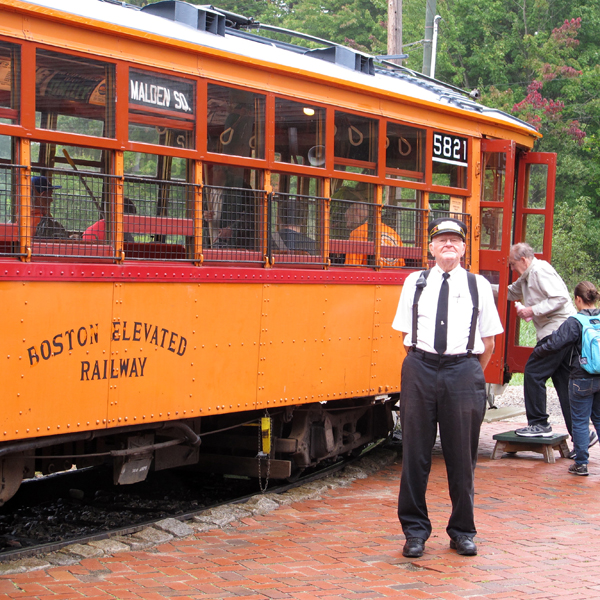
Volunteer conductors welcomed me to ride the refurbished Boston Elevated Railway trolley (photo 9). Intending to share our hobby with the public, I mentioned that I run an elevated railway in my backyard. One conductor, John Middleton, asked if my husband built it for me; when I shook my head, he guessed, “You must be Nancy Norris!” We both laughed, and then John shared that he is one of the Maine Garden Railway Society (http://mgrsmembers.blogspot.com) members who would meet me the next week in Massachusetts for the Ames’ operations session.
Regional gardening reports
Zones are USDA Hardiness Zones
How does your railway fit into New England?
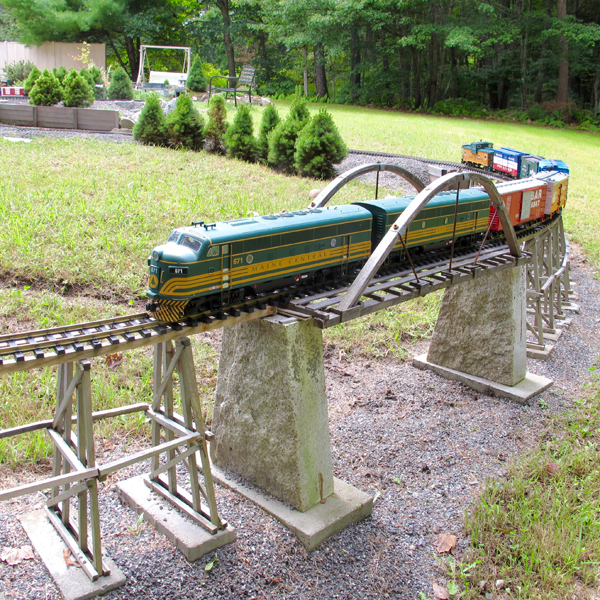
Terry Norton
Eliot, Maine, Zone 5-6
Granite strong
Our backyard, surrounded by trees and bushes, is mostly flat but, where a small slope in the rear leads down to a stream, we needed help to keep the railway flat. Up the road apiece, Raitt’s Stoneyard (http://awraitt.com), deals in large, ornamental granite pieces, like keystones for granite arches, that also work well in the railway as bridge piers. We also made low granite foundation walls to surround our scale construction site, found in the cast-off pile. Larger pieces form the bases of three mountains.
One mountain, with an abandoned fire tower, is topped with oregano (Oreganum vulgare ‘Pizza Night’, Zones 5-9). Sue works part time at our church and uses their groundcovers—lemon thyme and oregano—to create many delicious meals.
Scott Gould
Cape Elizabeth, Maine, Zone 5
Concrete strong
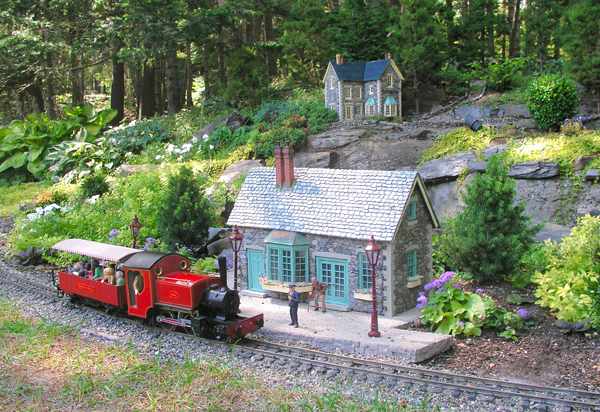
Sixteen years or so ago I built a railway that loops atop a mound of rock in the center of our backyard. I was agile then, but still had difficulty reaching tracks above a pond. Now, with my 75th birthday rapidly approaching, only my grandkids can reach that track. Last summer I decided to build a point-to-point line at the base of the mound, along the grass that runs beside the pond. But floating a track on ballast, the way most of us build our garden railway, wouldn’t work because I couldn’t hose grass clippings off the rails without washing off the gravel. I decided instead to pour a concrete roadbed.
Tips for operating in rough terrain
Roadbed: On the ground, secure your roadbed with 1) adequate depth of gravel, or 2) build a solid spline under track, or 3) use a manufactured roadbed. Build bridges across low or problem areas with good abutments. Build a raised roadbed whenever possible. Use benchwork.
Track cleaning: If running with track power, clean rail tops with a pole sander (Home Depot) instead of a hand-held cleaner, or run LGB’s track-cleaning engine (see advertisements). To remove plant debris, use a track sweeper car. Convert track-power to battery power (youtube.com/watch?v=AgwYXmerj204). Run live steam.
Garden: Plant hardy, native and drought-tolerant plants. Intersperse native woods and fields with some miniature plants near the track. Even native plants need irrigation to get established. Terrace garden beds to avoid erosion.
Search www.Trains.com for the bolded keywords to find related articles.
Extras
Scott Gould’s concrete roadbed
A travel article about the Seashore Trolley Museum by Brian Soloman
Rene Schweitzer visits the Seashore Trolley Museum blog post






